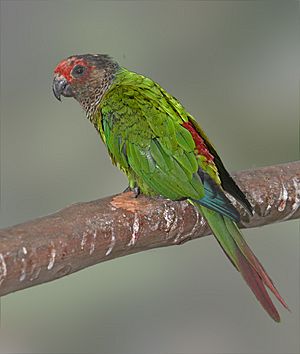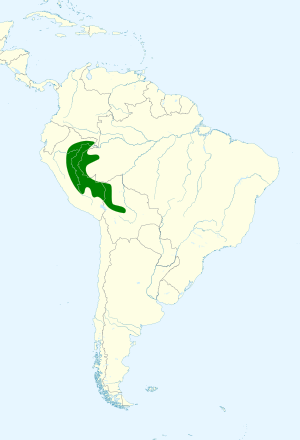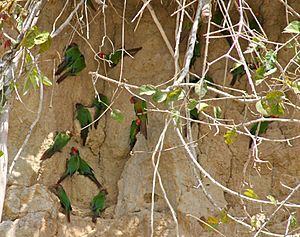Rose-fronted parakeet facts for kids
Quick facts for kids Rose-fronted parakeet |
|
|---|---|
 |
|
| Pyrrhura r. roseifrons | |
| Conservation status | |
|
LC (IUCN3.1 (but see the Status section))
|
|
| Scientific classification | |
 |
|
| Range of P. r. roseifrons | |
| Synonyms | |
|
Pyrrhura picta roseifrons |
The rose-fronted parakeet (Pyrrhura roseifrons) is a colorful bird from the parrot family. People who keep birds sometimes call it the rose-fronted conure. You can find these parakeets in parts of Bolivia, Brazil, Ecuador, and Peru in South America.
Contents
About This Bird
How Scientists Classify Them
The way scientists classify the rose-fronted parakeet has changed over time. For many years, it was thought to be a type of painted parakeet. But studies in the early 2000s showed it was different enough to be its own species.
Now, most scientists agree there are four main types, called subspecies, of the rose-fronted parakeet:
- P. r. peruviana
- P. r. dilutissima
- P. r. parvifrons
- P. r. roseifrons (This is the original type, also called the nominate subspecies.)
Sometimes, you might hear this bird called the red-crowned parakeet. But this can be confusing because there's another bird in New Zealand with a similar name.
What They Look Like
Rose-fronted parakeets are about 20 to 23 centimeters (8 to 9 inches) long. Both male and female birds look the same.
The most common type, P. r. roseifrons, has a bright red head and face. The feathers around its ears are a dirty white color. Most of its back is green, with a maroon-red lower back. Its throat and chest are dark, with light edges on the feathers. The middle of its belly is deep red, and the rest of its underside is yellowish-green. Its wings are mostly green, with blue feathers at the tips. The tail is maroon.
Their eyes are orange-brown or dark brown, with pale pink or black skin around them. Their beak is blackish, and their legs and feet are grayish-black. Young parakeets look like adults but don't have the red on their head and face.
Other types of rose-fronted parakeets have slightly different colors. For example, P. r. peruviana has a deep maroon forehead and a greenish-blue front of its head. P. r. dilutissima is similar but has less blue and more rusty-red on its face. P. r. parvifrons looks a lot like the main type but has a dark brown head and a deep red-brown face.
Where They Live
These parakeets live in different areas of South America:
- P. r. peruviana: Found in southeastern Ecuador and northeastern Peru.
- P. r. dilutissima: Lives in the Apurímac River valley in central Peru.
- P. r. parvifrons: Found in eastern San Martín and west-central Loreto departments in Peru.
- P. r. roseifrons: Lives south of the Amazon River, from northern Peru down to northern Bolivia, and east into Brazil.
They like to live in lowland evergreen forests and nearby open areas. In Peru, they can be found as high as 1,650 meters (5,410 feet) above sea level.
Behavior and Life
Movement
Scientists don't know much about how these parakeets move around or if they migrate.
What They Eat
Rose-fronted parakeets often feed in groups of up to 30 birds. They eat a variety of foods, including fruits, seeds, flowers, and leaves. They find their food from both wild and farmed plants and trees.
Reproduction
In northeastern Peru, rose-fronted parakeets breed between January and March. A nest was found in southeastern Peru in early October. It was in a hole in a live tree, about 9 meters (30 feet) off the ground. The nest had three eggs and one newly hatched chick. Four adult parakeets were taking care of the nest.
Their Calls
When flying, rose-fronted parakeets make "rolling bursts of prrrt prrrt notes." They also make screeching sounds and other chattering noises when talking to each other.
Conservation Status
The International Union for Conservation of Nature (IUCN) says that the rose-fronted parakeet is a species of "Least Concern." This means that it is not currently in danger of disappearing.
Even though their population is believed to be decreasing, there are no immediate major threats. These birds live in some protected areas. While some of their forest homes are being cut down, the pet trade does not seem to affect them much.
See also
 In Spanish: Perico de frente rosada para niños
In Spanish: Perico de frente rosada para niños


